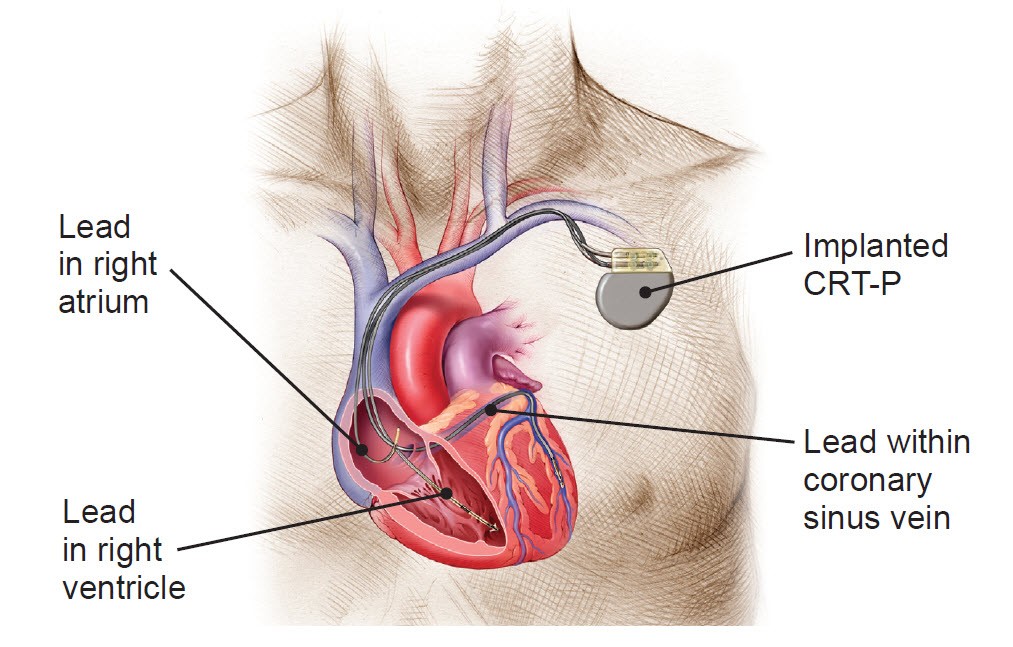AICD & CRT implantation at Cordis Cathlab
People with heart failure can benefit from AICD & CRT, the medical devices used for stabilizing your heartbeat. These devices send electrical impulses to your heart every time it skips a beat, beats faster or slower than normal, or pumps too much blood. The main purpose of these electrical devices is to protect your heart and regulate blood flow. The doctors implant a CRT under your skin and attach 2-3 leads to your heart.
It is made of two components:
- A small computer and a battery in a small metal device, placed under the skin of your abdomen
- Leads (insulated wires) that connect CRT to your heart and pass the electrical impulses from the device to your heart.
AICD (automatic implantable cardioverter-defibrillator) and CRT (cardiac resynchronization therapy) devices are used in people suffering from heart failure, irregular heart rhythms, and those with a history of cardiac arrest. Heart failure occurs when the left and right ventricles are unable to contract and expand as usual. This results in the reduced ability of your heart to pump blood at a required rate.

Experienced Cardiologist
How Does it Work?
CRT is designed to improve your cardiac function. The device is connected to the right and left ventricle of your heart. The doctor programs it to send electrical impulses when it detects an unusual heartbeat.
CRT sends electrical impulses through the leads to your heart muscles when the heart rate drops below the minimum limit programmed by your doctor. The impulses contract the left and right ventricles, stabilizing the beat and ensuring a proper blood flow through your heart. Depending on the condition of your heart, the doctor might attach the leads to the right atrium, right ventricle, and left ventricle.
AICD is a similar device programmed to regulate your heart rhythm and prevent sudden death. People with poor blood flow to the heart, a history of heart attack or heart failure, and an enlarged heart can benefit from AICD. The batteries can last for five years and deliver up to 100 shocks.
How are AICD and CRT Implanted?
Your doctor will provide you with instructions to get you prepared for the surgical implantation of CRT. Do not eat or drink a few hours before the procedure, especially transparent liquid. You must also avoid blood-thinning medication and any supplements that control your heart rate. The doctor starts an IV (intravenous line) to keep the incision site sterile throughout the operation. During this process, the incision site is cleaned with a special soap, and soft straps are used to prevent you from touching the incision area. The doctor gives you antibiotics to prevent the risk of infection.
The doctor uses a defibrillator, electrocardiogram, oximeter monitor, fluoroscopy, and blood pressure monitor to monitor your heart rhythms during the implantation. They inject local anesthesia to numb the area. They made a small incision to insert leads into your heart and implant them on the left and right ventricles. They use a fluoroscopy machine for accurate positioning of the leads. One end of these leads is connected to your heart muscles, and the other end to the pulse generator. The process takes between 2 and 5 hours (depending on the surgical approach used for implantation).
After the successful placements of the leads, the doctors test the leads to see if they are functioning appropriately. During the testing, the doctors send electrical impulses via the lead to your heart muscles to see if the muscles are contracting and pumping blood correctly. After the testing, the doctor connects these leads to the metal case and programs its settings.
Once the doctor injects local anesthesia, you shouldn’t feel any pain on the incision site. The surgery shouldn’t cause any serious side effects, although slight discomfort is absolutely normal for the first 48 hours following the surgery. You have to spend a night in the hospital. The doctor monitors your heart rhythms during your stay. The doctor might test this electrical device for a few hours and record your heart rhythm. The doctor performs an X-ray to see the location of the device and its functioning.
Is it Safe?
The implantation procedure is very safe, but it carries some risks like any other invasive treatment. Contact your doctor if you feel pain, discomfort, or other unusual problems in your chest after CRT implantation. Discuss your medical history with the doctor to know if you are a good candidate for AICD and CRT implantation.
Request Appointment
Request an appointment with us to know more about angiography procedure and if you do require an angioplasty
